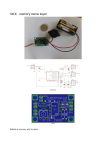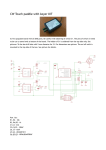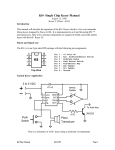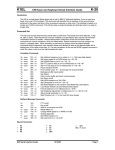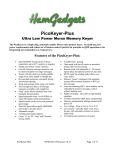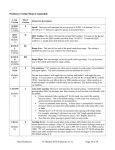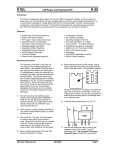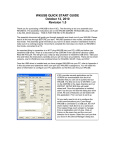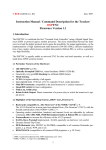Download Memory morse keyer
Transcript
Memory morse keyer Usage After reset in default mode, the keyer operates as regular IAMBIC keyer in IAMBIC B at 12 WPM (words per minute = 60 CPM). The sidetone generator operates at 800 Hz. Speed Change Speed can be changed py pressing and holding the command key while operating the DIT and DAH paddles. DIT reduces speed while DAH increases speed. The keyer plays an alternating sequence of dit and dah while changing speed without keying the transmitter. Command mode Pressing the command button without changing speed will switch the keyer into command mode. This will be confirmed with the '?' character. Another press of the same button takes the keyer back into regular keyer mode and will be confirmed by a single dot. During command mode the transceiver is never keyed and sidetone is always activated. Further functions can be accessed by keying one-letter commands as listed below. V - Version The keyer responds with the current keyer software version number P - Pitch Allows modifying the sidetone pitch to a higher or lower level. A sequence of dits will be played and the pitch can be modified with the dit and dah paddles. If no paddle is touched for 5 seconds, OK is sounded and the mode terminates, leaving the user in command mode. R - Reset All settings are returned to their default values except for the stored messages in the message buffers. Restored settings include speed and pitch, Paddle Swap, TX level inversion, sidetone and TX keyer settings. U - Tune mode The transceiver is keyed for a duration of 20 seconds for tuning purposes. Tuning mode is aborted once either DIT or DAH paddles are touched or the control key is pressed. A - IAMBIC A Keyer sets IAMBIC A as permanent keying mode. Request is answered with "A OK". B - IAMBIC B Keyer sets IAMBIC B as permanent keying mode. Request is answered with "B OK". L - Ultimatic Sets the keyer into ULTIMATIC mode. In Ultimatic mode always tha last paddle to be touched is repeated indefinitely when paddles are squeezed D - DAH priority mode. In squeezed state a sequence of DAHs is sent. Some of the first generation keyers exhibited this behaviour so the chip can simulate that X - Paddle swapping DIT and DAH paddles are swapped. Request is answered with "OK". S - Sidetone toggle The builtin sidetone generator setting is toggled (ON -> OFF or OFF -> ON). NOTE: This setting is only of relevance for regular keying mode. Sidetone is always on in command mode. Request is answered with "OK". K - TX Keying toggle Toggles the setting of the TX keyer output. In default state the keyer switches the output line when it is in keyer mode. Toggling this setting enables or disables that function. NOTE: Keying is always off in Command mode. Request is answered with "OK". Z - Set Farnsworth pause Allows setting of an extended inter-character Pause in all sending modes which makes fast keying easier to understand. Note that this of course only influences RECEPTION, not TRANSMISSION. If you desire farnsworth mode in transmission, please manually pause during characters. I - TX level inverter toggle This function toggles wether the "active" level on the keyer output is VCC or GND. This setting is dependent on the attached keying circuit. Request is answered with "OK". W - Query current WPM speed Keyer responds with current keying speed in WPM. 1 and 2 - Record internal messages 1 or 2 The keyer immediately responds with "1" or "2" after which a message up to 100 characters can be keyed at current WPM speed. After 5 seconds of inactivity the message is played back once and then stored in EEPROM. Choosing "1" or "2" but not keying a new message deletes the chosen message buffer content. E and T - Play back internal messages 1 or 2 The stored messages 1 or 2 are played back with keying enabled (if configured). A press of the command key immediately returns the keyer to keyer mode so a QSO can be started. N - Automatic Beacon The keyer responds with "N" after which a number between 0 and 9999 can be keyed. After a 5 second timeout the keyer responds by repeating the number and "OK". Once the keyer returns to keyer mode, the content of message buffer 2 is repeated in intervals of n seconds. The setting is preserved in EEPROM so the chip can be used as a fox hunt keyer. Returning to command mode and entering an interval of 0 (or none at all) stops beacon mode. 0 - Lock configuration The 0 command locks or unlocks the main configuration items but not speed, pitch and playback functions. C - Callsign trainer The keyer plays a generated callsign (sidetone only) and the user must repeat it. If it was repeated correctly, "R" is played and the next callsign is given. If a mistake was sensed, the error prosign (8 dots) is sounded and the current callsign is repeated again for the user to try once more. If nothing is keyed for 10 seconds, the keyer returns to command mode. hamshop.cz



